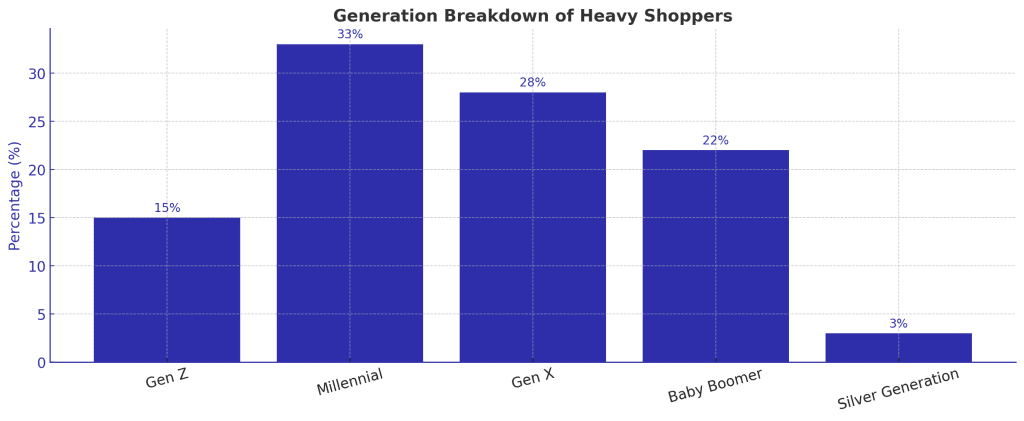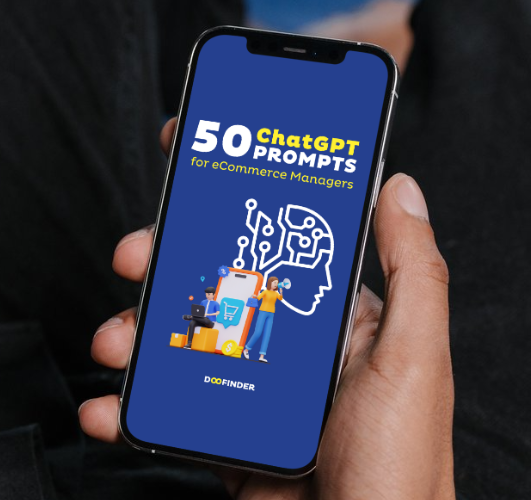Gen Z—those born between the late 1990s and early 2010s—is already making a huge impact in the world of retail. They don’t just buy products—they engage, question, and expect more from the brands they support. For businesses, understanding this generation isn’t just good, it’s essential for success.
We recently conducted a study on the evolving online consumer landscape and uncovered some key insights. In this article, we’ll share five crucial takeaways that online stores need to understand in order to engage, convert, and keep Gen Z shoppers.

Gen Z Shopping Habits: Digital and Physical
While Gen Z is often called a “digital native” generation, their buying behavior is a bit more hybrid. Although 15% of heavy online shoppers (those who make over two-thirds of their purchases online) are Gen Z, they still visit physical stores more often than other generations, usually after discovering products online.
According to a McKinsey report, 60% of Gen Z consumers use both online and offline touchpoints before making a purchase, and they’re twice as likely as Boomers to research online and then buy in-store. For Gen Z, it’s not just about convenience, when shopping they want to feel in control, validate their choices, and trust the brand.
For this generation, online and offline shopping aren’t two separate worlds—they blend them together. Brands need to create experiences that merge the digital and the physical.
Strategies to Merge Digital and Physical Retail for Gen Z
Retailers who view digital and physical retail as complementary rather than competing channels will be in the best position to attract Gen Z. To merge these experiences effectively, here are three key strategies:
- Offer “Buy Online, Pick Up In Store”: Give customers the flexibility to shop online and pick up their purchases in person, providing convenience without sacrificing the in-store experience.
- Enable Real-Time Inventory Checks: Allow shoppers to check the availability of products in-store before they visit, ensuring a seamless and efficient shopping experience.
- Ensure Unified Branding Across Touchpoints: Maintain consistent messaging and design across both digital and physical channels, so customers experience a cohesive brand identity no matter how they interact with your business.

Social Media is Gen Z’s New Storefront
For Gen Z, social media isn’t just where they socialize—it’s where they shop, discover brands, and decide who to trust. In the Doofinder UK eCommerce Study, Gen Z stood out for wanting significantly more interactive content, entertainment, and user-generated posts from brands than any other age group.
Specifically, 44% of Gen Z respondents want interactive formats like polls and challenges, far above the average consumer.
The data shows social presence builds trust for Gen Z, and they place significantly more trust in brands that show up consistently and authentically on platforms like Instagram, TikTok, and YouTube. They’re not looking for polished ads, instead they want creators they relate to, real reviews, and behind-the-scenes content. In the UK and across Europe, this generation is fueling the rise of the “shoppertainment” economy—where engaging content doubles as a storefront.
For eCommerce brands, this means investing in community-driven content, micro-influencer partnerships, and brand storytelling that’s made for feed, not just for sales. Those that speak Gen Z’s social language will win attention, loyalty, and conversions.
The Definition of a Shoppertainment Economy: The “shoppertainment economy” blends shopping and entertainment, where brands use interactive content to make the experience more fun. It includes live-streamed shopping, influencer partnerships, and user-generated content, often on platforms like Instagram, TikTok, and YouTube. This trend especially appeals to younger consumers, like Gen Z, who enjoy an immersive way to discover and buy products.
To Earn Gen Z Trust, Lead with Purpose
For Gen Z, brand values aren’t a bonus—they’re a requirement. According to the online consumer report, Gen Z is significantly more likely than other consumers to care if a brand supports social causes like sustainability, inclusion, or mental health. Purpose-driven messaging has become a key influence on their purchase decisions.
Global trends echo this. A McKinsey report found that 73% of Gen Z are willing to pay more for sustainable products, and 70% prefer brands aligned with their beliefs. But this generation is also deeply skeptical—performative messaging is quickly called out. The 2024 Edelman Trust Barometer shows Gen Z is the least trusting generation, yet the most loyal when that trust is earned.
Brands must align their purpose with action. Authenticity is non-negotiable in Gen Z advertising. It’s not just about talking about values—it’s about proving that you are living them.
AI and Personalization are Expected
Gen Z is at the forefront of AI adoption—they are 46% more likely than other generations to embrace tools like chatbots, smart recommendations, and dynamic search filters. Far from shying away from data use, this generation is actually more open to sharing personal information if it leads to more relevant, personalized shopping experiences.
This makes personalization not just a bonus, but an expectation. Brands that use AI to tailor product suggestions, messaging, and offers—while being transparent about how data is used—will build stronger trust and engagement with Gen Z.
To learn more about how AI tools can transform your retail strategy, check out our detailed article on AI tools in eCommerce. Or discover how personalized shopping experiences can help you connect with your customers in our latest piece on personalization.
Discounts Drive Gen Z Consumer Behavior
While Gen Z may be purpose-driven, they are also practical. They respond strongly to discount periods, even more than older consumers. Alongside Millennials, they are the generation most likely to spend more when prices drop. Seasonal sales, flash deals, and loyalty-based offers remain highly effective. However, these promotions should feel exclusive and tailored—especially when combined with the kind of personalized communication they expect from digitally-savvy brands.
Conclusion
Gen Z may be young, but their influence on retail is already reshaping the landscape. As highlighted in our 2025 UK eCommerce Study, they’re a key segment of heavy online shoppers, fast adopters of AI, and expect far more from brands than previous generations—especially on social media and social values.
Whether you’re wondering who Gen Z is or how to create lasting engagement, remember:
- They are fluid between online and in-person commerce.
- They prioritize purpose and digital fluency.
- They’re skeptical—but fiercely loyal when trust is earned.
To win Gen Z, brands must go beyond convenience. Online stores need to combine purpose, relevance, and innovation at every step of the customer journey. The future of eCommerce belongs to those who truly connect with this generation’s values and expectations.
Want to dive deeper into today’s consumer behavior? This article zooms in on Gen Z—but our full 2025 Consumer Landscape Report covers insights across all generations, including Millennials, Gen X, Boomers, and more. Download the full report for free to get a complete picture of how shopping habits are evolving and where the biggest opportunities lie.









